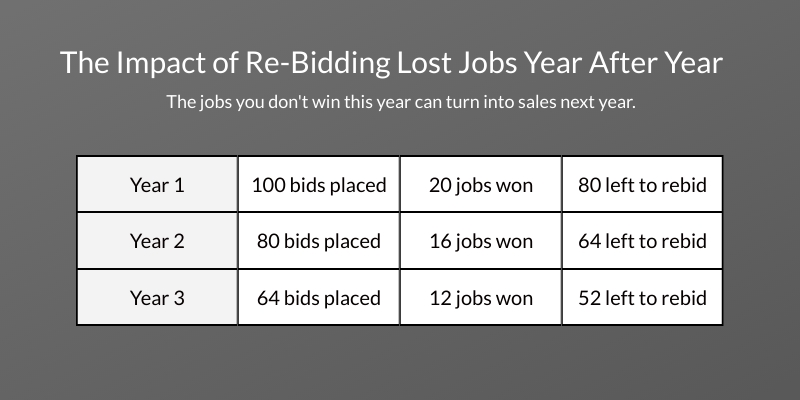5 Common Sales Mistakes Landscapers Make – and How to Avoid Them
No matter how long you’ve been in business, you want more sales.
You could spend money and time trying to figure out ways to grow your sales, but sometimes the answer is right in front of you: it’s as simple as eliminating common mistakes that may exist in your sales process.
We’ve identified 5 mistakes landscape companies make during the sales process and have come up with solutions that are easy to implement, so you can build better relationships with your clients, win more jobs in less time, and grow your company.
We will cover the following mistakes:
- Not using sitemaps to sell your bid
- Poor Follow-Up
- Not following up at all
- Not re-bidding lost jobs
- “Guesstimating” and approximating
Let’s dive in!
1. Not Using Sitemaps to Sell Your Bid
Imagine two companies pursuing the same job. One salesperson presents only a spreadsheet filled with numbers, while the other presents both a spreadsheet and a color-coded sitemap that connects the data with visual indicators such as labels, drawings, and notes. One tells you the numbers; one shows you the work they plan to provide.
Which salesperson is more likely to win the job?
You guessed it! The salesperson who presented a visual representation of the work to support the numbers has a higher chance of success. Why? A picture says a thousand words and creates immediate understanding. It also sets you apart from the competition.
Sitemaps are powerful sales and communication tools and are a key selling tool throughout the sales process. Presenting a decision-maker with a sitemap lets you show that you understand the work to be performed so you can quickly get on the same page.
You can use Go iLawn to create a professional, visual sitemap to share with your client after asking the right questions to figure out exactly what they need. Go iLawn’s precision measuring tools allow you to defend your measurement data and the color-coded and grouped drawings allow you to more easily communicate which areas of the property need certain services. You can even use labels to call out site hazards or to note specifications and instructions on the property.
As an added bonus, you can use Go iLawn ShareView™ to send an interactive, yet non-editable version of your sitemap to your prospect. It’s a professional, technology-forward way to show your prospect that you understand their needs.
2. Poor Follow-Up
In today’s world, people are busy and often wear many hats in their roles. Your clients and prospects will appreciate thoughtful communication and follow-up.
One easy way to help your client understand your value is to ask them how they’d like you to follow up. Do they prefer email, text, a phone call, a Zoom meeting, or getting together in person? What time of day do they prefer? How many days away will they expect your call?
Research shows that “42% of people [are encouraged to] purchase if the sales rep call[s] back at an agreed-upon, specified time.” Imagine if you could increase your close rate to 42%!
To help your follow-up meeting go more smoothly and to demonstrate your company’s value, leave the prospect with any supporting documentation or information that will help them make an informed decision. This can include:
- Your Go iLawn sitemap: Point out additional opportunities or send a different view of the property in your follow-up.
- Your pricing structure: Explain why your company offers the best value and why your pricing structure supports that.
- A bid packet: Include supporting information for the bid or more about your company.
- Direct contact information: Include specific timing for the next review and the prospect’s preferred method of communication.
3. Not Following Up At All
Failing to follow up entirely with your prospect creates an enormous strain on your professional relationship with them.
A 2021 study found that “60% of customers say no four times before saying yes.” Following up is crucial to building a relationship with your leads and ensuring your company stays top-of-mind as they work their way through the sales cycle. It can be as simple as sending a thank-you note or even leaving a small token of your appreciation after a meeting.
To ensure your salespeople follow up with every prospect, you can put systems in place to handle every step of the sales process. Use a fully integrated business management system like Aspire to track each opportunity through the sales funnel.
Visibility of your pipeline allows you to quickly identify leads who have not yet made it to the next step while also letting you easily track sales activities, such as appointments and tasks, related to each property and opportunity.
You can even set up tasks to create follow-up reminders to notify you of your planned sales activities.
4. Not Re-Bidding Lost Jobs
Reminder: It costs the same amount of time and resources to make a sale as it does to lose one. However, even if you lose a sale, you still have a valuable investment that pays dividends if you re-bid the job. Here’s why:
The sitemaps from the lost sale are still a valuable asset. You’ve already absorbed the costs to measure the property and prepare a bid. Therefore, your cost to rebid the property is a fraction of what it was the first time. Now it’s time to put the law of averages into play.
Because property managers’ situations are always changing, there are opportunities to win the job in the future if you just ask. The law of averages states: if you lose 10 jobs, and next year you re-bid those 10 jobs, you should win some of those jobs.
For example: Let’s say you have a 20% close rate and you bid on 10 jobs – you should win 2 of them. Next year, you should re-bid on the remaining 8 that you lost. By your average close rate, you should close at least one of those, and you don’t have to spend extra time or resources to win that job since you already had it measured. Now, you have 7 properties to re-bid the following year, and you should close at least one of those, again, cost-free.
Instead of leaving lost customers to your competitors, use Go iLawn to easily follow up with them next year! Go iLawn stores every sitemap in your account, so you can re-bid lost customers in a matter of minutes. It’s an almost cost-free sales activity since you will not have to re-measure the property. Your only cost is the few minutes that your salespeople may spend on the phone. It’s quick and easy (and free) to adjust the map to meet any new requests or requirements.
You can also use Go iLawn’s Tag System to group similar projects. For example, if you lost any bids in the 2021 season, you can add a tag for “2022 Re-Targeting Campaign” to each measured sitemap that will allow you to easily identify prospects to re-bid next year.
5. “Guess-timating” and Approximating Prices
“Guesstimating” occurs when you approximate the measurements, materials, and time for a job.
Let’s look at two bakers. Baker one uses memory and approximation to make a batch of chocolate chip cookies. Sometimes they turn out great, other times they are too salty, other times too bland. Baker two references his recipe each time he makes a batch of cookies, repeating his process in a reliable, predictable manner. As a result, his cookies are always perfect, and his bakery sales reflect that.
Using exact measurements and processes allows you to mitigate the unnecessary risks that leave you reliant on one person’s guessing ability. You risk mistakes that cost you more in the long run.
You can’t win jobs and grow your company without measurements. Accurate measurements allow you to create accurate estimates, place bids with accurate pricing, order the correct material amounts, and staff the right number of crew members on a job.
Go iLawn lets you create accurate measurements for any property with precision measuring tools and high-resolution, leaf-off aerial imagery. Or, take it to the next level with Go iLawn InstantEstimator to get automated time and material estimates as you measure.
Now you can apply the measurements and estimates to your pricing structure, job planning, material ordering, and more – creating a ripple effect of accuracy and precision across the entire organization. With accurate data, you can better serve your clients, identify areas for improvement across the company, and grow your business.
How Many Mistakes Will You Eliminate?
The first step to winning more sales is to identify which mistakes you are making. Eliminating just one mistake can have a major impact on your close rate.
As always, Go iLawn is here to help!










Leave a Reply
Want to join the discussion?Feel free to contribute!